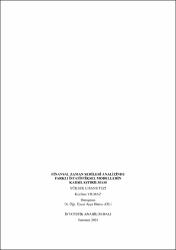| dc.contributor.advisor | Atlı, Ayça Hatice | |
| dc.contributor.author | Yılmaz, Keziban | |
| dc.date.accessioned | 2021-08-16T11:21:11Z | |
| dc.date.available | 2021-08-16T11:21:11Z | |
| dc.date.issued | 2021 | en_US |
| dc.identifier.uri | https://hdl.handle.net/11630/9103 | |
| dc.description.abstract | Bu çalışmanın temel amacı; BIST 100, FTSE 100, NIKKEI 225 ve S&P 500 endekslerinin getirilerinin incelenmesinde Box-Jenkins modelleri ile ARCH/GARCH ailesi modellerinden ARCH (koşullu değişen varyans), GARCH (genelleştirilmiş koşullu değişen varyans), EGARCH (üstel genelleştirilmiş koşullu değişen varyans) ve GJR-GARCH (Glosten, Jagannathan ve Runkle GARCH) modellerinin kullanımını araştırmaktır. Uygun ARMA modellerinin belirlenmesinin ardından inşa edilen koşullu değişen varyans modellerinin tahminleri; normal dağılım, t dağılımı ve genelleştirilmiş hata dağılımı ile bunların çarpık uzantıları altında elde edilmiştir. Modeller için gerçekleştirilen bir dizi grafiksel ve istatistiksel değerlendirmenin sonucunda, EGARCH ve GJR-GARCH modellerinin ARCH ve GARCH modellerinden daha iyi performans sergilediği görülmüştür. Ayrıca normal ve çarpık normal dağılımların diğer dağılımlara göre daha kötü performans sergilediği belirlenmiştir. Bunlara ek olarak, endekslerin negatif şoklardan pozitif şoklara göre daha fazla etkilendikleri belirlenmiştir. Bununla birlikte, kötü haberlerin BIST 100 endeksini diğer endekslere göre daha az etkilediği, şokların volatiliteyi BIST 100 endeksinde diğer endekslere göre daha uzun süre etkilediği sonucuna varılmıştır. | en_US |
| dc.description.abstract | The main purpose of this study is to investigate the use of Box-Jenkins models and ARCH (autoregressive conditional heteroskedasticity), GARCH (generalized autoregressive conditional heteroskedasticity), EGARCH (exponential GARCH) and GJR-GARCH (Glosten, Jagannathan and Runkle GARCH) from ARCH/GARCH family models for examining the returns of BIST 100, FTSE 100, NIKKEI 225 and S&P 500 indices. Predictions of conditional heteroskedasticity models constructed after the determination of suitable ARMA models are obtained under the normal distribution, the t distribution, and the generalized error distribution and their skew variants. As a result of a series of graphical and statistical evaluations performed for the models, it was seen that EGARCH and GJR-GARCH models outperformed ARCH and GARCH models. Furthermore, it was determined that the normal and skewed normal distributions performed worse than the other distributions. It has also been determined that indices were more affected by negative shocks than positive shocks. On the other hand, it was concluded that bad news affected BIST 100 index less than other indices, and shocks affected volatility in BIST 100 index longer than other indices. | en_US |
| dc.language.iso | tur | en_US |
| dc.publisher | Fen Bilimleri Enstitüsü | en_US |
| dc.rights | info:eu-repo/semantics/openAccess | en_US |
| dc.subject | Borsa endeksi | en_US |
| dc.subject | ARCH | en_US |
| dc.subject | GARCH | en_US |
| dc.subject | EGARCH | en_US |
| dc.subject | GJR-GARCH | en_US |
| dc.title | Finansal zaman serileri analizinde Farklı istatistiksel modellerin karşılaştırılması | en_US |
| dc.title.alternative | Comparison of different statistical models In financial time series analysis | en_US |
| dc.type | masterThesis | en_US |
| dc.department | Enstitüler, Fen Bilimleri Enstitüsü, İstatistik Ana Bilim Dalı | en_US |
| dc.authorid | 0000-0002-2548-9231 | en_US |
| dc.identifier.startpage | 1 | en_US |
| dc.identifier.endpage | 114 | en_US |
| dc.relation.publicationcategory | Tez | en_US |
| dc.contributor.institutionauthor | Yılmaz, Keziban | |



















